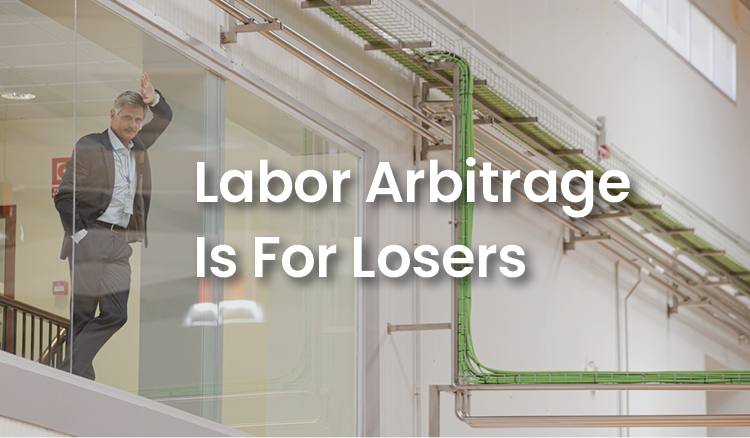Labor Arbitrage is for Losers
There’s a panic starting to reverberate in certain circles. For the OG operations strategists out there, we have to bite our tongues and watch the chickens finally come home to roost. The panic, of course, stems from the impact of H2B visas and tariffs. The fear of both exposes an age-old truth: labor arbitrage is for losers. It’s always been the negligent bureaucrat’s favorite tactic to squeeze out minor cost savings on labor instead of prioritizing a sophisticated and robust operations strategy that delivers superior financial performance. The shrieking we’re hearing now is not really about lost savings – it’s the recognition that it takes real work and competent leaders to build a winning operating model, and for many companies those muscles haven’t been exercised in decades.
The 40 Year Labor Arbitrage Grift is Coming to an End
In order to understand the current panic, we must rewind the tape back nearly 40 years to when the loser mentality started becoming the prevailing mentality. Let’s say, as an example, you’re running a successful metals company in the US in the late 1980s. The traditional profitability goals are now complexified by increasing globalization and technology threats/opportunities. You have to be more cost effective to compete on the global stage while continuing to improve your service, quality, product offerings, etc. – always a difficult task to do more with less, but that’s the sober reality of basic economic progress.
You end up facing two choices: 1) do the hard work and figure out how to harness the right ideas to develop a winning operations strategy, or 2) avoid the thinking work, keep things the same, and exploit low cost regions for labor arbitrage. An overwhelming number of US companies opted for the latter. If you just move a portion of your operations to a low cost country, you can keep everything else the same and claim the quick cost out in time for your annual performance review. Same result if you import the labor arbitrage through a H2B visa program. Same result with LCC strategic sourcing. The goal for the negligent bureaucrat, of course, is to claim a benefit in time for the big annual review – he’ll get the promotion and be on to the next thing. The new person will be stuck sorting out the mess and then face the same dilemma next year. Unsurprisingly, the ‘new-person-same-as-the-old-person’ will double down on more arbitrage opportunities for the same reasons as the predecessor.
Play this out over 40 years and you end up in 2025 with an entire sector devoid of operational sophistication and entirely reliant on foreign exploitation to meet profitability targets. Meanwhile, all the great ideas and technologies have been collecting dust on the shelves, those pesky employees with the great ideas have been sidelined, and the losers running the arbitrage plays have risen the ranks. Tariffs and H2B visa restrictions threaten this grift, but the shrieking is coming from the halls of the 7th floor, not the factory floor. For the factory floor, we have the biggest opportunity of a lifetime.
Returning to First Principles and Dispelling Myths
In order to attack a complex problem, it’s usually best to return to first principles and follow the logic. First principles in this case are unit level economics, e.g., cost per unit sold. Your average US-made product may contain 5-15% variable labor cost at average US manufacturing wages. This represents your full baseline for potential labor-related savings. If there’s a 20% arbitrage with H2B visa labor, this only delivers 1-3% overall profitability uplift. Outsourcing usually ends up in similar territory. Note: many negligent bureaucrats will contend they’ve gotten much higher savings but I’ve made a career out of exposing their bad math and selective calculations. When you account for total landed cost – all the new costs introduced netted against the savings from the labor arbitrage – of an outsourced product, you almost always have low single digit EBITDA impact. About 25% of these decisions even end up value-destructive with negative EBITDA impact. This is a dirty secret that many know and have been too cowardly to expose. Hard to explain to the machinist in Detroit that he/she lost a job and the company didn’t even have the competence to profit from it.
Now, consider the reality that at least 50% of all direct labor costs are non-value-add no matter where the labor resides. This isn’t due to the same reasons that the average Silicon Valley employee does less than 10% value-add work in a day. It’s not about wasting 90% of the work day in the coffee shop, pretending to ‘work’ from home, or sitting through worthless meetings. On the shop floor, it’s a culmination of real-world issues like looking for parts, waiting for parts, looking for tools, interpreting drawings, changeovers, rework, etc. Eliminating just half of this non-value activity achieves the same P&L impact as any H2B visa or outsourcing play. This is why labor arbitrage is for losers – the correct approach is known, is superior, but requires some effort, creativity, and – God forbid – going to Gemba.
Embrace Kaizen and Walk the Gemba!

There’s currently no labor shortage in the US and there’s certainly no shortage of labor productivity opportunities. When DOGE exposes the fake DOL/BLS statistics soon, we’re going to see how much excess capacity we truly have in this country (and perhaps even see some pitchforks and tribunals directed at the deep state Apparatchik behind the phony statistics used to keep rates up and citizens poor). The necessary ingredients are all on the table for this country: plenty of unutilized manpower, untapped ideas, under-served technologies, and time-tested methodologies like TPS/Lean, etc. We just have to bake the cake.
Start by walking the Gemba and diving into the problems that have been ignored for years. Resist the temptation to play the losers game and get your hands dirty. Draw out the vision for your business and select the right tools necessary to achieve that outcome. Some early adopters of Veryable have achieved 5X revenue growth, 25% profitability gains, 95%+ service levels because they resisted the temptation to follow the 40-year pattern of lazy labor arbitrage plays. Instead, they designed a sophisticated operating model that actually delivers an operational competitive advantage and they are winning big in the market because of it.
Labor arbitrage is synonymous with decay. Operational transformation and Kaizen are rejuvenation. Eliminating H2B exploitation and imposing tariffs are just smart policies to ween us off of 40-year destructive habits. As is the case for any detox, there’s going to be some chaos to manage through, but I promise you it will pass faster than you might think and the world of possibilities will look much different through sober eyes. We believe Veryable is the right first step on the operational transformation journey but we are not alone. There is a world of innovation and ideas ready and waiting to be tools on your journey. This is the way, Western Man.
For more information about how Veryable can help you scale and manage uncertainty in your operations, click here.
Previous Posts
Why Your Operation Isn’t Too Complex or Specialized for On-Demand Labor
The Future of Manufacturing and Logistics
Create a free business profile today to explore our platform.






